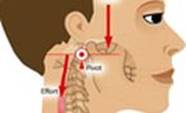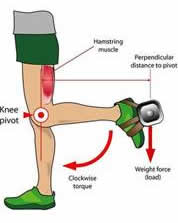Levers and Body Parts

Adapted from: http://www.sciencelearn.org.nz/Contexts/Sporting-Edge/Looking-closer/What-levers-does-your-body-use
Mechanical advantage
Muscles and bones act together to form levers. A lever is a rigid ro d (usually a length of bone) that turns about a pivot (usually a joint). Levers can be used so that a small force can move a much bigger force. This is called mechanical advantage.
d (usually a length of bone) that turns about a pivot (usually a joint). Levers can be used so that a small force can move a much bigger force. This is called mechanical advantage.
There are four parts to a lever – lever arm, pivot, effort and load. In our bodies:
bones act as lever arms
joints act as pivots
muscles provide the effort forces to move loads
loads are the body parts that are being moved
Levers can also be used to magnify movement, for example, when kicking a ball, small contractions of leg muscles produce a much larger movement at the end of the leg.

 Types of Levers
Types of Levers
Class 1 lever – nod your head
The pivot is the place where your skull meets the top of your spine. Your skull is the lever arm and the neck muscles at the back of the skull provide the force (effort) to lift your head up against the weight of the head (load). When the neck muscles relax, your head nods forward.
Class 2 lever – stand on tip toes


Tip-toe
The pivot is at your toe joints and your foot acts as a lever arm. Your calf muscles and Achilles tendon provide the effort when the calf muscle contracts. The load is your body weight and is lifted by the effort.
The load is between the pivot and the effort (like a wheelbarrow). The effort force needed is less than the load force, so there is a mechanical advantage. This muscular movement at the back of your legs allows you to move your whole body a small distance.
Class 3 lever – bend your arm


Bent arm
The pivot is at the elbow and the forearm acts as the lever arm. The biceps muscle provides the effort (force) and bends the forearm against the weight of the forearm and any weight that the hand might be holding.
The load is further away from the pivot than the effort. There is no mechanical advantage because the effort is greater than the load. However this disadvantage is compensated with a larger movement – a small contraction of the biceps produces a large movement of the forearm. This type of lever system also gives us the advantage of a much greater speed of movement.
What is torque?
In the examples above, the effort and load forces have acted in opposite rotation directions to each other. If a load tries to turn the lever clockwise, the effort tries to turn the lever anticlockwise. Forces acting on a lever also have different effects depending how far they are away from the pivot. For example when pushing a door open it is easier to make the door move if you push at the door handle rather than near to the hinge (pivot). Pushing on the door produces a turning effect, which causes rotation. This turning effect is called torque (or leverage).
 You can increase the amount of torque by increasing the size of the force or increasing the distance that the force acts from the pivot. That’s why the door handle is far away from the hinge.
You can increase the amount of torque by increasing the size of the force or increasing the distance that the force acts from the pivot. That’s why the door handle is far away from the hinge.
Hamstring
Forces from our muscles produce torques about our joints in clockwise and anti-clockwise directions. If the torques are equal and opposite, the lever will not rotate. If they are unequal, the lever will rotate in the direction of the greater torque.
In this diagram, the load and weight of the lower leg produce a clockwise torque about the knee. The lower leg will rotate in a clockwise direction.
If the hamstring muscle at the back of the upper leg contracts with a strong force, it produces an anticlockwise torque that holds the leg up.

Lifting heavy weights
In this diagram, lifting the weight like the person on the left produces a greater torque about the lower spine (pivot) – the lifting force is at a greater perpendicular distance to the pivot. The back muscles must exert a huge force to provide a torque that balances the torque from the weight being lifted.
It is important to lift a heavy weight close to your body to reduce the torque produced around your lower spine
Name _____________________________________________
QUESTIONS:
1. As you left a barbell, your arm is acting as what type of lever?
a. class 1 b. class 2 c. class 3
2. As you stand on your tip toes your foot is acting as what type of lever?
a. class 1 b. class 2 c. class 3
3. What is the LOAD of the lever as you stand on your tiptoes?
a. your ankle b. calf muscles c. your whole body
4. What part of your body acts at the pivot points to levers?
a. joints b. muscles c. weights
5. Another name for a pivot point is the:
a. output b. torque c. fulcrum
6. If you place the doorknob on the same side of the door as the hinge, you will ____ the torque.
a. increase b. decrease c. not change
7. Why is it better to lift objects using your legs instead of your back?
a. torque forces may injure back muscles
b. the leg is a stronger lever
c. the back does not have as much torque as the ankle
8. What is the overall theme of this article?
a. to describe how body parts act as levers
b. to advise people on how to lift objects
c. to persuade readers to exercise
9. When a force tries to push one end of a lever clockwise, a balancing force on the opposite side (to the fulcrum) must push:
a. clockwise also b. counterclockwise
10. The hamstring muscles are used to perform watch action?
a. raising the upper leg b. bending over c. bending the knee

